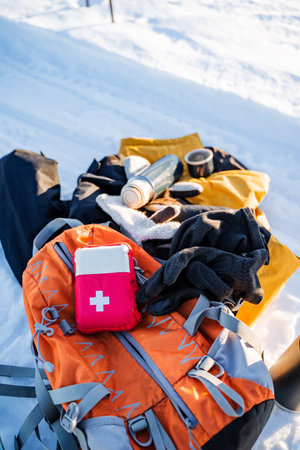Introduction to First Aid Preparedness in the UK Outdoors
Venturing into the wild landscapes of the United Kingdom—whether it’s tackling the rugged Scottish Highlands, rambling through the Lake District, or exploring the windswept coastal paths of Wales—demands a level-headed approach to safety and first aid. The UK’s famously unpredictable weather, from sudden downpours to bone-chilling winds, can turn a straightforward hike into a survival challenge within minutes. Add to this the remoteness of many popular walking routes and you quickly realise that being prepared isn’t just sensible; it’s absolutely essential. Local hazards such as slippery rocks, stinging nettles, ticks, and fast-flowing rivers are ever-present, and rescue services might be hours away in an emergency. For anyone embarking on outdoor adventures in Britain, understanding the importance of packing the right first aid and safety kit is the first step towards self-reliance and resilience in the face of adversity.
Core First Aid Kit Components
Every British adventurer knows that a well-prepared first aid kit is the backbone of outdoor safety. Whether youre trekking the Lake District, wild camping in the Scottish Highlands, or navigating the rugged Cornish coast, your kit must be ready for anything the unpredictable UK weather and terrain can throw at you. Below is a detailed breakdown of essentials designed to handle common injuries and illnesses encountered in UK outdoor settings:
| Item | Purpose | UK-Specific Notes |
|---|---|---|
| Adhesive Plasters (Various Sizes) | Cover minor cuts and blisters | Include waterproof types for wet conditions |
| Sterile Gauze Pads & Bandages | Treat larger wounds, control bleeding | Essential for falls on rocky paths or scrapes from brambles |
| Cohesive Bandage Roll | Support sprains, secure dressings | Useful for twisted ankles on uneven trails |
| Antiseptic Wipes/Cream | Clean and disinfect wounds | Prevents infection from muddy or boggy ground |
| Tweezers & Safety Pins | Remove splinters, ticks, secure bandages/clothing | Ticks are increasingly common in rural UK areas; check after walks through tall grass or heather |
| Moleskin/Blister Plasters | Prevent/treat blisters from long hikes in boots | A lifesaver on damp days when feet are prone to chafing |
| Pain Relief (Paracetamol/Ibuprofen) | Manage headaches, minor pains, reduce inflammation | Always carry in original packaging for easy identification during emergencies |
| Anti-histamines | Treat allergic reactions from stings or plants (e.g., nettles) | Nettle rash and insect bites are frequent annoyances in UK countryside |
| Rehydration Salts/Sachets | Treat dehydration from strenuous activities or heatwaves | Even British summers can catch you out; always be prepared for exertion-induced dehydration |
| Emergency Foil Blanket | Retain body heat if stranded or injured in cold/wet weather | The UKs changeable climate makes this non-negotiable year-round gear |
| Medical Gloves (Nitrile) | Hygiene when treating wounds, especially with others injuries | Keeps infections at bay and your kit compliant with basic safety standards |
Pro Tips for Packing Your UK First Aid Kit:
- Waterproof Everything: Use zip-lock bags or dry sacks to keep supplies dry in classic British drizzle.
- Customise by Season: In summer, add sunburn relief gel; in winter, include extra hand warmers.
- Add a Basic Instruction Leaflet: Especially useful if group members have varying levels of first aid knowledge.
Packing Smart for British Terrain:
Your first aid kit isn’t just a legal tick-box — it’s your lifeline. Regularly check expiry dates and restock after every trip. Adapt your kit size and contents according to group numbers and planned remoteness. With these essentials close at hand, you’re equipped to handle the most common mishaps unique to British adventures.

3. Critical Safety Equipment for British Terrain
When venturing into the distinctive landscapes of the UK—be it the misty moors, dense woodlands, or rugged uplands—having the right non-medical safety kit can mean the difference between a minor mishap and a major emergency. British weather is notoriously fickle, and terrain conditions change rapidly, so your pack must cover more than just first aid.
Hi-Vis Gear: Be Seen, Stay Safe
Whether you’re trekking on Dartmoor or navigating Yorkshire’s wild expanses, visibility is crucial. High-visibility vests or bands are essential, especially in low light or foggy conditions common across the UK countryside. These ensure rescue teams or fellow hikers can spot you quickly if you become lost or injured. Opt for lightweight, waterproof materials that won’t add bulk to your kit.
Whistle: Sounding the Alarm
A sturdy emergency whistle is a must-have in every British adventurer’s pack. If you’re stranded or need to attract attention from afar—especially where mobile signals are unreliable—a whistle’s sharp blast carries far better than shouts. Three short blasts are universally recognised as a distress signal in the UK outdoors.
Torch: Light Your Way
The UK’s early nightfall and sudden mists make a reliable torch (flashlight) indispensable. Choose a robust, weatherproof model with spare batteries, or better yet, go for a head torch to keep your hands free. Avoid relying solely on your phone’s torch—it’s not built for harsh conditions and drains your battery rapidly.
Navigation Tools: Don’t Rely Solely on Tech
Boggy moorland and labyrinthine woods can easily disorient even seasoned explorers. Always carry an Ordnance Survey map appropriate to your area and a traditional compass. While GPS devices are handy, they’re prone to failure in remote areas and aren’t foolproof against dead batteries or poor satellite coverage. Being able to navigate old-school style remains vital across Britain’s unpredictable terrain.
Other Handy Safety Essentials
Add items like a compact multi-tool, spare paracord, and waterproof matches to your safety arsenal. Each serves multiple roles—whether for basic repairs, emergency shelter rigging, or signalling for help in the wildest corners of the British Isles.
Summary
Packing these critical non-medical safety items isn’t just about ticking boxes; it’s about respecting the unique hazards of British outdoor adventures. Equip yourself properly, and you’ll have peace of mind knowing you’re prepared for whatever the UK countryside throws at you.
4. Weather-Proofing Your Kit
When venturing into the UK’s great outdoors, preparing for the weather is not just wise—it’s essential. The unpredictable British climate can turn from sunshine to a biting squall within minutes, whether you’re rambling across the Lake District or hiking in the Highlands. Proper weather-proofing of your kit ensures safety, comfort, and the preservation of your crucial first aid supplies.
Waterproof Storage Solutions
Keeping your essentials dry is paramount. Even a short downpour can ruin bandages, plasters, and electronic devices if left unprotected. Employ heavy-duty dry bags and zip-lock pouches for all sensitive gear. For longer treks, consider a rucksack liner as an added layer of defence against moisture.
| Item | Recommended Use | UK Outdoor Scenario |
|---|---|---|
| Dry Bags (various sizes) | Organise and seal medical kits, clothing, electronics | Dartmoor drizzle or coastal walks in Cornwall |
| Rucksack Liners | Complete internal protection for main pack contents | Sustained Scottish rain or sudden Peak District showers |
| Zip-Lock Freezer Bags | Quick access for small first aid items, matches, ID cards | Muddy footpaths and boggy Yorkshire Dales terrain |
Thermal Blankets & Emergency Warmth
The risk of hypothermia is real, even in summer months—chilled winds and wet conditions can sap body heat alarmingly fast. Always carry at least one thermal (space) blanket per person. These are light, compact, and reflect up to 90% of body heat back to the user. In more remote areas or during winter expeditions, an emergency bivvy bag or insulated sleeping mat can be literal lifesavers.
Key Tips for UK Weather Preparedness
- Layer Up: Wear moisture-wicking base layers and always pack a waterproof outer shell—Gore-Tex or similar fabrics offer solid protection without bulk.
- Shelter from Wind: A compact windproof tarp provides rapid shelter on exposed ridges or open moors.
- Check Local Forecasts: Mountain weather can change hourly; apps like the Met Office provide crucial updates before setting off.
- Acclimatise Gear: Adjust contents seasonally—extra hand warmers for frosty mornings in Wales or sunblock for a rare Suffolk heatwave.
Toughen Up Your Kit for Every UK Adventure
No matter where you roam—from Devon’s misty tors to the blustery edges of Ben Nevis—a weather-proofed kit means you’re prepared to face whatever the British Isles throw at you. Invest in quality storage solutions and thermal gear; these aren’t luxuries but survival essentials when adventure turns rough.
5. Dealing with Local Wildlife and Natural Hazards
Exploring the British outdoors means coming face-to-face with hazards that are uniquely local. While our wilds aren’t teeming with deadly predators, there are still plenty of risks to manage if you want your adventure to remain safe and enjoyable. Here’s how to handle some of the UK’s most notorious natural threats.
Ticks: Small But Dangerous
Ticks are more than just a nuisance—they can transmit Lyme disease, which is no joke. When rambling through woodlands or crossing heathland, always pack tick removal tools in your first aid kit. Wear long sleeves, tuck your trousers into your socks, and use insect repellent containing DEET for extra protection. After your trek, check yourself thoroughly for ticks and remove them promptly using a proper tick remover, not your fingers or regular tweezers.
Stinging Nettles: The Ubiquitous Menace
If you’ve spent any time off-path in the UK, you’ll know that stinging nettles are everywhere. To deal with their irritating sting, carry antihistamine cream or hydrocortisone ointment in your kit. If you get stung, wash the area with clean water as soon as possible before applying cream. Wearing gloves and keeping your legs covered will help prevent getting stung in the first place.
Adders: Britain’s Only Venomous Snake
The adder is shy but can strike if startled—especially in sunny spots on heathland and moors. If bitten, stay calm and keep movement to a minimum to slow the spread of venom. Immobilise the limb, call 999 immediately, and never try to suck out the venom or apply a tourniquet. Packing a pressure bandage could be vital until help arrives.
Other British Hazards Worth Noting
Boggy ground, brambles, and even aggressive livestock can pose their own set of challenges. For bogs and marshes, waterproof boots are essential; for brambles and thorns, pack plasters and antiseptic wipes for minor cuts and scrapes. If you encounter cows or other large animals, give them a wide berth—especially during calving season—and never get between mothers and their young.
Hard-Won Tips from Veteran Ramblers
Your first aid kit should reflect these very British hazards: include tick removers, antihistamines, snake bite instructions, waterproof plasters, and antiseptics. Knowledge is your best defence—know what you might face before setting out so you’re ready to handle whatever nature throws at you.
6. Signalling and Emergency Communication
When venturing into the wilds of the UK, from the rugged Highlands to the remote Lake District fells, being able to alert Mountain Rescue or summon help is a matter of life and death. Every serious outdoorsperson should have a solid plan for emergency communication. Here’s how to stack the odds in your favour when things go sideways.
Keep Your Mobile Charged and Ready
In Britain, mobile coverage can be patchy once you’re off the beaten track, but your phone remains your primary lifeline. Always set out with a fully charged battery and consider carrying a robust power bank as backup. Switch your device to flight mode while not needed to conserve energy, but keep it accessible. In an emergency, dial 999 or 112—these numbers work even without signal from your usual provider if any network is available.
Store Essential Emergency Contacts
Preload your phone with local Mountain Rescue contact details and an ICE (In Case of Emergency) number. If you’re walking in National Parks or popular hiking areas, research the nearest rescue posts before heading out. A small waterproof card with key contacts written down can be a lifesaver if technology fails or your phone gets damaged.
Location-Sharing Tips for Swift Rescue
Knowing where you are is half the battle. Apps like OS Locate, What3Words, or even Google Maps offline mode can pinpoint your position for rescuers. Practise using these apps ahead of time—don’t wait until you’re lost in fog on Dartmoor. Share your planned route and estimated return time with a trusted contact at home; this simple step triggers early alarms if you don’t check in as planned.
Best Practices for Alerting Mountain Rescue
- If lost or injured, stay put unless remaining in place puts you at greater risk—rescue teams need a fixed location to find you quickly.
- Use a whistle (six blasts, pause, repeat) or torch flashes as traditional distress signals if electronic communication fails.
- Avoid draining your phone by sending unnecessary updates—conserve power for critical moments.
Final Word on Emergency Prep
No kit is complete without reliable means to call for help. The UK’s unpredictable weather and varied terrain demand respect—plan ahead, pack smart, and know exactly how you’ll summon aid when every minute counts.
7. Quick Tips: Packing Light but Ready
When venturing into the wilds of the UK—be it the Scottish Highlands, Welsh valleys, or Lake District fells—packing for both safety and comfort is a delicate art. Overburden yourself and you’ll struggle on muddy tracks; skimp on essentials and you risk being caught out by Britain’s famously fickle weather. Here’s how to strike that vital balance between robust preparedness and a manageable rucksack weight for your outdoor adventures.
Choose Multi-Use Kit
Opt for gear that serves more than one purpose. For example, a survival blanket can double as emergency shelter or groundsheet. A buff can act as a scarf, hat, or even a bandage in a pinch. This approach trims down what you carry without sacrificing readiness.
Streamline Your First Aid Kit
No need to lug around an entire pharmacy. Stick to the basics: assorted plasters, sterile wipes, blister pads, painkillers, antihistamines, and tape. Add any personal medication and a compact CPR face shield. Repack items into ziplock bags to shave off extra grams.
Mind the Weather—but Don’t Overpack
British weather is unpredictable, so always bring waterproofs and a warm layer even in summer. However, avoid duplicating clothing “just in case.” Trust in quick-dry fabrics and layering systems instead of carrying heavy spares.
Prioritise Safety Essentials
Certain items should never be left behind: whistle, small torch (with spare batteries), map and compass (even if you have GPS), and a fully charged mobile phone in a waterproof pouch. These weigh little but could prove life-saving.
Keep Hydration and Nutrition Simple
Take a reusable water bottle (consider one with an integrated filter) and high-energy snacks like oat bars or nuts. There’s no need to overstock—plan refills at known water sources along your route when possible.
Pack Smart, Not Heavy
Lay out everything before packing; question each item’s necessity. Use compression sacks for clothing and group smaller bits into pouches for quick access. Finally, keep heavier items close to your back and low in the rucksack for better balance on rugged British trails.
The goal is simple: be ready for trouble without letting your pack drag you down. With careful selection and ruthless efficiency, you’ll move faster, stay safer, and enjoy every mile of Britain’s magnificent outdoors.


